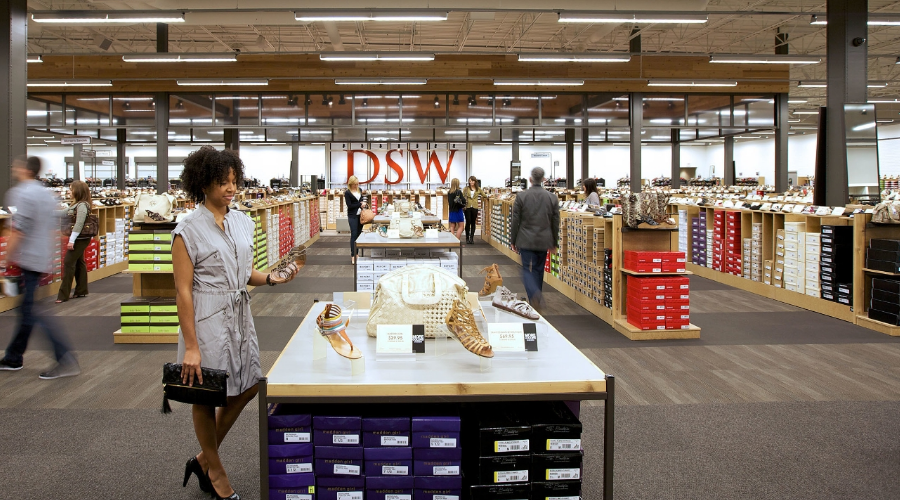By Thomas J. Ryan
DSW Inc. (NYSE:DSW) reported that its second-quarter earnings declined, as expected, and announced a number of additional cost-saving measures to shore up its bottom line in the second half. But results overall improved over the previous quarter and management again raved about the performance and potential of its athletic offerings.
While overall comps slid 1.2 percent in the period, athletics grew 13.5 percent, continuing a strong trend in recent quarters.
On a conference call with analysts, Deborah Ferree, DSW’s vice chairman and chief merchandising officer, said athletic saw positive comps in both performance and fashion offerings but fashion is “really comping positive.” The opportunity is also being supported by an athleisure influence “popping up in the women’s fashion brands and that’s a pure plus from last year.”
She added, “I look at that whole business athletic and athleisure as continuing on the same momentum and the trajectory and growth not slowing down at all.”
In the quarter ended August 4, earnings fell 33.4 percent to $25 million, or 30 cents a share. Excluding costs related to the Ebuys acquisition and restructuring activities, adjusted net income was $29.1 million, or 35 cents, down 22.6 percent compared to the year-ago period but ahead of Wall Street’s consensus target of 29 cents.
Sales increased 5.1 percent to $659 million due to new stores and $19.6 million from Ebuys. Sales trends were similar to the first quarter but transactions improved due to tactical local marketing efforts. Digital demand grew 21 percent, reflecting omnichannel investments.
By category, combined women’s athletic and non-athletic comps were in line with the overall small comp decline. With athletic’s continuing momentum, DSW increased its total athletic penetration by more than 200 basis points in the quarter in women’s, according to Ferree. It also expanded its women’s athleisure offerings with a broad number of fashion sport brands, which added another 500 basis points of penetration toward the athletic lifestyle in the quarter.
Ferree was also encouraged by “the results and the new fashion looks in dress,” which produced healthy positive regular price comps. DSW’s overall sandal business was flat as cooler weather impacted its seasonal sandal business, offsetting strength in dress sandals.
In men’s, combined athletic and non-athletic comp was also in line with the chain average, with athletic again outperforming other categories.
Ferree said DSW overall continues to shift resources in the key brands and styles that support the fashion casual lifestyle.
“We have assembled our strongest athletic assortment this fall season, including styles from some of the biggest brands in the athletic space, and we are significantly increasing the amount of exclusive merchandise this year,” said Ferree. “We are also pursuing a number of initiatives that will elevate DSW as an important destination for the fashion athletic consumer in the coming years.”
Roger Rawlins, DSW’s CEO, noted that the company “distorted” its athletic offerings at a small number of stores to double athletic penetration in those locations
“What we saw was when we offer more athletic choices to the customer, we sell more athletic products,” said Rawlins. “So the real challenge now is to figure out how do we maximize the athletic assortment in our stores, without impacting the balance of the assortment. This is critical for optimizing future category distortions, as well as growing our kids assortment to the rest of the chain.”
While accessories comps continued to be depressed, the category’s gross margin rate improved by close to 200 basis points.
After a two-year pilot, kids was launched to close to half the chain and is performing to plan. Ferree said the new category is leading to improvements in traffic and higher units per transaction.
DSW’s bottomline was impacted by a decrease in adjusted gross margin by 210 basis points due to lower initial markup, higher markdowns and the addition of Ebuys, which operates at a significantly lower gross profit rate than the DSW flagship business. Gross profit pressure improved slightly versus the first quarter.
Looking ahead, DSW continues to expect to earn in the range of $1.32 to $1.42 per share for the full year, which would be down from $1.54 the prior year. Comps are also still expected decline in the low-single digits.
DSW is positioning lower receipts for fall to minimize markdown risk. One category taking a hit will be boots, which is being planned down slightly versus the prior year due to weather risks. Said Ferree, “I would rather go in leaner and chase with the customer wants rather than going with an aggressive plan.”
As a result, gross profit is expected to improve from the 230 basis point decline experienced in the spring season to a flattish level in the back half.
In addition to buying more conservatively, a number of other newer programs are expected to support profitability. These include an order routing algorithm that continues to optimize store fulfillment of digital orders as well as improved sourcing costs through better vendor accountability and stronger negotiations. Increasing the depth of key item buys are expected to lower unit costs and improve in-stock levels for high-velocity items to support margins. Finally, a new private brands partnership, which will include a new young, fashion-conscious men’s label as well as an affordable fashion girls one, are expected to become “more meaningfully accretive next year.”
As part of its previously-announced expense review, about $25 million of annualized cost savings from organizational realignment, procurement, and business process improvements was identified. Approximately 30 percent of these cost savings will benefit 2016 and the savings will reduce its operating expense growth from 8 percent year-to-date to a mid-single-digit growth rate in the fall season.
Its SG&A rate in the second half is expected to be flat, despite $9 million needed for incentive compensation as well as the negative low single-digit comps expected. For the back half of the year overall, earnings are expected to expand at a mid-single-digit rate.
Photo courtesy of DSW.
















